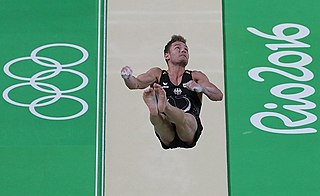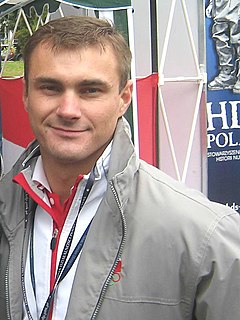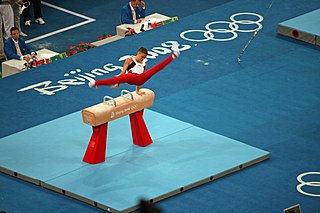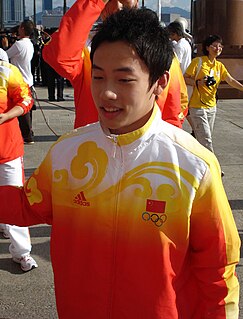
Gymnastics is a sport that includes physical exercises requiring balance, strength, flexibility, agility, coordination, and endurance. The movements involved in gymnastics contribute to the development of the arms, legs, shoulders, back, chest, and abdominal muscle groups. Gymnastics evolved from exercises used by the ancient Greeks that included skills for mounting and dismounting a horse, and from circus performance skills.

Rhythmic gymnastics is a sport in which gymnasts perform on a floor with an apparatus: hoop, ball, clubs, ribbon or rope. The sport combines elements of gymnastics, dance and calisthenics; gymnasts must be strong, flexible, agile, dexterous and coordinated. Rhythmic gymnastics is governed by the International Gymnastics Federation (FIG), which first recognized it as a sport in 1963. It became an Olympic sport in 1984, with an individual all-around event. The group all-around competition was added to the Olympics in 1996. At the international level, rhythmic gymnastics is a women-only sport. The most prestigious competitions, besides the Olympic Games, are the World Championships, World Games, European Championships, European Games, the World Cup Series and the Grand Prix Series. Gymnasts are judged on their artistry, execution of skills, and difficulty of skills, for which they gain points. They perform leaps, balances and rotations along with handling the apparatus.
At the 2000 Summer Olympics, three different gymnastics disciplines were contested: artistic gymnastics, rhythmic gymnastics, and trampoline. The artistic gymnastics and trampoline events were held at the Sydney SuperDome on 16–25 September and 22–23 September, respectively. The rhythmic gymnastics events were held at Pavilion 3 of the Sydney Olympic Park on 28 September – 1 October.
At the 2004 Summer Olympics in Athens, Greece, three disciplines of gymnastics were contested: artistic gymnastics, rhythmic gymnastics and trampoline. The artistic gymnastics and trampoline events were held at the Olympic Indoor Hall and the rhythmic gymnastics events were held at the Galatsi Olympic Hall.
At the 1984 Summer Olympics, two different gymnastics disciplines were contested. In addition to the fourteen artistic gymnastics events contested, for the first time at the Olympics, a rhythmic gymnastics event was contested–the women's individual all-around. All of the gymnastics events were held at UCLA's Pauley Pavilion in Los Angeles from July 29 through August 11. Several teams who had qualified to compete were absent as a result of the 1984 Summer Olympics boycott, including the Soviet Union, Bulgaria, Cuba, Czechoslovakia, East Germany, Hungary, and North Korea.
At the 1988 Summer Olympics, two different gymnastics disciplines were contested: artistic gymnastics and rhythmic gymnastics. The artistic gymnastics events were held at the Olympic Gymnastics Hall in Seoul from September 18 through 25th. The rhythmic gymnastics events were held at the same venue from September 28 through 30th.

The men's horizontal bar competition was one of eight events for male competitors of the artistic gymnastics discipline contested in the gymnastics at the 2004 Summer Olympics in Athens. The qualification and final rounds took place on August 14 and August 23 at the Olympic Indoor Hall. There were 79 competitors from 29 nations, with nations competing in the team event having up to 5 gymnasts and other nations having up to 2 gymnasts. The event was won by Igor Cassina of Italy, the nation's first victory in the horizontal bar and first medal of any color in the event since 1928. Paul Hamm took silver, the United States' first horizontal bar medal since 1992. Bronze went to Isao Yoneda of Japan, the once-dominant nation's first medal in the event since 1984.

The men's vault competition at the 2008 Summer Olympics was held on August 9 and 18 at the Beijing National Indoor Stadium. The eight competitors with the highest scores in qualifying, among the gymnasts electing to make two vaults, proceeded to the men's vault finals. There, each gymnast performed two vaults; the scores from the final round determined final ranking. There were 16 competitors from 13 nations that made a second vault attempt. The event was won by Leszek Blanik of Poland, the nation's first victory in the men's vault. Blanik was the seventh man to win multiple medals in the event, adding to his 2000 bronze. France earned its first medal in the event with Thomas Bouhail's silver. Anton Golotsutskov of Russia took bronze, putting the nation back on the podium after a one-Games absence.

The men's pommel horse competition at the 2008 Summer Olympics was held on August 17 at the Beijing National Indoor Stadium. The eight competitors with the highest scores in qualifying proceeded to the men's pommel horse finals. There, each gymnast performed again; the scores from the final round determined the final ranking. There were 76 competitors from 27 nations that competed on the pommel horse, with nations in the team event entering up to 5 gymnasts while other nations could enter up to 2. The event was won by Xiao Qin of China, the nation's second consecutive and third overall victory in the pommel horse. The other two medals went to nations that had never earned a medal in the event before: Filip Ude of Croatia took silver while Louis Smith of Great Britain finished with bronze.

The men's rings competition at the 2008 Summer Olympics was held on August 18 at the Beijing National Indoor Stadium. The eight competitors with the highest scores in qualifying proceeded to the men's rings finals. There, each gymnast performed again; the scores from the final round determined final ranking. There were 70 competitors from 25 nations that competed on the rings, with nations in the team event entering up to 5 gymnasts while other nations could enter up to 2. The event was won by Chen Yibing of China, the nation's first victory in the rings since 1984. Yang Wei, also of China, took silver. Bronze went to Oleksandr Vorobiov, the nation's first medal in the event.

The men's parallel bars competition at the 2008 Summer Olympics was held on August 9 and 19 at the Beijing National Indoor Stadium. The eight competitors with the highest scores in qualifying proceeded to the men's parallel bars finals. There, each gymnast performed again; the scores from the final round determined the final ranking. There were 75 competitors from 27 nations that competed on the parallel bars, with nations in the team event entering up to 5 gymnasts while other nations could enter up to 2. The event was won by Li Xiaopeng of China, the first man to win three medals in the parallel bars as well as the first man to win two non-consecutive gold medals in the same apparatus. Yoo Won-Chul of South Korea took silver. Anton Fokin won Uzbekistan's first parallel bars medal in its debut as an independent nation.

The men's horizontal bar competition at the 2008 Summer Olympics was held on 9 and 19 August at the Beijing National Indoor Stadium. The eight competitors with the highest scores in qualifying proceeded to the men's horizontal bar finals. There, each gymnast performed again; the scores from the final round determined final ranking. There were 76 competitors from 27 nations that competed on the horizontal bar, with nations in the team event entering up to 5 gymnasts while other nations could enter up to 2. The event was won by Zou Kai of China, the nation's first victory in the horizontal bar. Jonathan Horton won silver, the United States' second consecutive Games with a silver medalist in the horizontal bar. Germany's Fabian Hambüchen won the first of his three medals in the event with bronze.
Women's rhythmic group all-around competition at the 2008 Summer Olympics was held at the Beijing University of Technology Gymnasium.
These are the results of the rhythmic individual all-around competition, the only Rhythmic Gymnastic event at the 1988 Summer Olympics.
These are the results of the rhythmic individual all-around competition, the only Rhythmic Gymnastic event at the 1992 Summer Olympics. The four pieces of apparatus used were ball, clubs, hoop, and rope. 42 gymnasts competed in the preliminary round.
Girl's rhythmic individual all-around competition at the 2010 Summer Youth Olympics was held at the Bishan Sports Hall.
Girl's rhythmic team all-around competition at the 2010 Summer Youth Olympics was held at the Bishan Sports Hall.

The Women's rhythmic individual all-around competition contested at the 2012 Summer Olympics. The event was held at the Wembley Arena on 9–11 August.
The girls' rhythmic individual all-around at the 2014 Summer Youth Olympics was held on August 26–27 at the Nanjing Olympic Sports Centre. There were two rounds of competition in the individual competition. In each round, competing gymnasts performed four routines. One routine was performed with each of the four apparatus: rope, hoop, ball and clubs. The combined scores from the four routines made up the preliminary qualifications round score. The top eight gymnasts after the preliminary round advanced to the finals. There, they performed each routine again. Scores from the preliminary will not be carried over, the gymnasts start back their routines with maximum of D10/E10 in base value.
The Women's rhythmic individual all-around competition at the 2020 Summer Olympics was held at the Ariake Gymnastics Centre in Tokyo, Japan, with the qualification taking place at 6 August and the final on 7 August.








